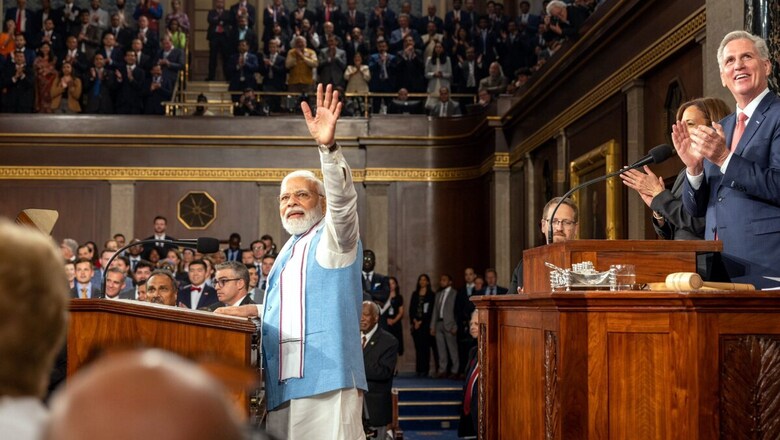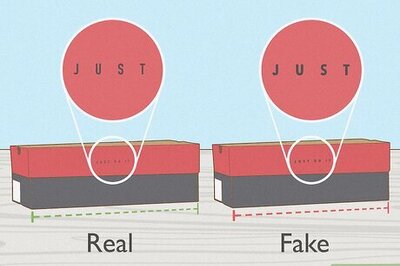
views
Over the last two decades, India and the United States have grown increasingly aligned, with the US providing greater military assistance to India to enhance its military capabilities in response to China’s rise. The US has supported India to advance its own strategic interests. As part of this, the US is helping India modernise its military capabilities.
Prime Minister Narendra Modi has visited the US five times for bilateral and multi-lateral meetings since 2014. But his visit on June 22 assumed significance because none of his earlier visits were classified as a ‘state visit’. The previous two state visits during President Biden’s Presidency have been by the French and South Korean Presidents. It is evident that the state visit, which is the most elevated form of American diplomacy, is being carefully crafted and choreographed as the relationship between the two countries is of great strategic consequence.
As the prime minister departed from India, he reaffirmed the significance of the trip: “I am confident that my visit to the US reinforce our ties based on shared values of democracy, diversity, and freedom. Together we stand stronger in meeting the shared global challenges.”
Activities Preceding the Visit
In a run-up to the visit, the US Secretary of Defence, Lloyd Austin, came to India on June 4 and 5 with the aim of reinforcing a major defence partnership and advancing cooperation in critical domains. His trip helped finalise agreements and set the table for the historic state visit.
The 2022 US National Defence Strategy called for more technology cooperation with allies and partners, which produced greater technology-sharing mechanisms with Australia (through the AUKUS deal) as well as with Japan. Now the United States appears poised to take some unprecedented steps towards India, the third partner in the Quad. Prior to that, on June 6, Foreign Secretary Vinay Kwatra visited Washington and attended the launch of the Strategic Trade Dialogue, one of the first outcomes of the Initiative on Critical and Emerging Technologies (iCET).
According to National Security Advisor Jake Sullivan, who visited on June 13, the iCET agenda is expanding and there’s “genuine commitment” between both sides to keep the initiative going. In his remarks, his counterpart Ajit Doval said the iCET will give an ‘orbital jump’ to the strategic relations between India and the United States.
Significantly, on June 19, the Secretary of State Antony Blinken visited China where both countries agreed to stabilise their intense rivalry so it does not veer into conflict, but failed to produce any major breakthrough. The trip was postponed in February after a suspected Chinese spy balloon flew through US airspace. “The relationship was at a point of instability, and both sides recognised the need to work to stabilize it,” Blinken said before leaving China. Chinese President Xi Jinping welcomed “progress” after shaking hands with Blinken at the Great Hall of the People, a grand venue usually reserved for greeting heads of state.
China, however, refused to entertain Washington’s bid to resume military-to-military communication channels, citing US sanctions as the obstacle. The two sides appeared entrenched in their positions over everything from Taiwan to trade, including US actions toward China’s chip industry, human rights and Russia’s war against Ukraine.
Prime Minister Modi’s Visit
Prime Minister Modi has deepened ties with the United States. He has had personal chemistry with three US Presidents — Obama, Trump and Biden — through increased partnerships in defence, advanced technology, energy, trade and many other aspects. In 2015, former US President Barack Obama was the chief guest for India’s Republic Day parade, the first by an American president.
While welcoming PM Modi at the White House, President Biden said, “The challenges and opportunities facing the world in this century require that India and the United States work and lead together, and we are.” President Biden and PM Modi hailed a new era in their countries’ relationship after the White House rolled out the red carpet for the Indian prime minister. “Two great nations, two great friends, and two great powers. Cheers,” Biden told Modi in a toast at a state dinner. Modi said in reply, “You are soft-spoken, but when it comes to action, you are very strong.”
The Deliverables
During his visit to India, Jake Sullivan had said, “A number of deliverables at the visit are not just bullet points on a page, they are fundamentally designed to remove those obstacles in defence trade, in high-tech trade, in investment in each of our countries, in taking away obstacles that have stood in the way of our scientists and researchers.”
The two countries announced agreements on semiconductors, critical minerals, technology, space cooperation and defence cooperation including joint manufacturing and sales. They also ended disputes at the World Trade Organisation, and India removed some tariffs on US goods. Amongst the landmark deals was the agreement with Hindustan Aeronautics Limited to allow General Electric to co-produce the GE-F414 fighter aircraft engine in India. It will power the LCA ‘Tejas’ Mk II and other future fighters.
Bharat Forge CMD Baba Kalyani said, “When we talk about fighter jets and engines, there are over 300 technologies that are used in making jet engines…I think there is going to be a large space for small, medium and large sectors to participate in this programme because one country alone cannot do everything by itself.”
US Navy ships in the region will now be able to stop in Indian shipyards for repairs under a maritime agreement, and India will procure US-made armed MQ-9B Sea Guardian drones.
The case for procuring 31 Armed Drones was cleared by the Defence Acquisition Council (DAC) chaired by the defence minister on June 15. The deal involves setting up MRO (Maintenance Repair and Overhaul) facilities in India. The MQ-9B Predator Armed Drones purchase will cost approximately $3.5 billion; as each cost over $100 million, which is nearly equal to the cost of PLA Air Force’s J-20 Stealth fighter jet.
Only a few NATO countries and close allies of the US have Predator Drones which are capable of firing missiles and precision-guided munitions. The Indian Navy has been using two unarmed Sea Guardian Drones on lease for ISR (Intelligence Surveillance and Reconnaissance) of the Indian Ocean Region and these were also deployed to monitor Chinese activities across the LAC. As per some reports, the US also offered Stryker combat vehicles and upgraded 155mm M777 howitzer with long-range PGM ammunition.
US chipmaker Micron Technology’s MoU plans a $2.7 billion semiconductor testing and packaging unit, to be built in Gujarat. The US will also make it easier for skilled Indian workers to get and renew US visas. India also agreed to join the US-led Artemis Accords on space exploration and to work with NASA on a joint mission to the International Space Station in 2024.
Indian Foreign Secretary Vinay Kwatra said, “The decisions taken during the visit are truly transformative across a wide range of areas. Naturally, it is something which is possible when the countries have deep trust in each other and are in it for long term.” During the Joint Press Conference, President Biden said, “Even the sky is not the limit.”
China Challenge
India’s foremost security challenge is clearly China, with Doklam and Galwan, dispelling any doubts. The clash in Galwan brought all like-minded countries together to realise what the China threat is all about. By posing a collusive threat with Pakistan and making inroads into Nepal, Myanmar, Sri Lanka Bangladesh and Bhutan, the Chinese attempt to contain both directly and through proxies.
To counter this in the immediate context, India needs intelligence, equipment, logistical support and weapons systems to deter China. Hence, with the US being a leading provider of these requirements, it is imperative for India to have closer collaboration with them and in turn to be willing to be part of a wider US deterrence in the Indo-Pacific. In the medium term, India needs to build its own military-industrial base. Hence, while it does have multiple partners in the form of Russia, France and Israel, the US with its technological edge will have a major role in ensuring India’s security concerns. Hence, the insistence on co-production, which has paid dividends. In the long term, it is equipping India with critical emerging technologies that have military applications and securing their supply chains. This is the region of semiconductors, AI, space cooperation, telecom and quantum infrastructure. India has the strengths but the US will help translate these strengths into capabilities.
The US identifies China as its “pacing” challenge and realises that India is one of the most important partners in its Indo-Pacific policy. While India actively counters China on its Northern border where no doubt it will fight alone, but moral and material support from the US due to its deepening relationship will help in countering China’s assertiveness and aggression. Highlighting increased technological cooperation, military coordination and intelligence sharing between the two countries, General Austin said, “This all matters because we face a rapidly changing world. We see bullying and coercion from the People’s Republic of China.”
The Global Times which works under the Chinese Communist Party had a cartoon that showed an elephant and a panda as boxers in the ring, gloves on, and raring to go at each other, with the US playing the referee albeit from outside the ring, and shouting: “Fight. Fight. Fight.” While this may represent a Chinese perspective, India as a country has never had any extra-territorial ambitions.
Conclusion
From the security perspective, India’s most immediate concern is along the Line of Actual Control, where China has made vast investments in military infrastructure, trying to push India from former patrolling points. Their incursions into Indian territory have led to a deterioration in relations. The US can help India reinforce its own capacity to deter such attacks which represents a precedent that could also intimidate other countries across the Indo-Pacific region. US defence collaborations and sales will help fill capability gaps including improving border surveillance with drones. A strong India on land can then result in it committing more forces towards the maritime domain which is where the interest lies.
The US also wants to help India bolster its domestic defence industry and increase military cooperation between the two countries in an attempt to wean India off its long dependence on Russia for its weaponry. While the breakthrough in relation to jet-engine manufacturing is welcome, the fine print of the manufacturing know-how and the design transfer between GE and HAL will have to be studied carefully for its technology transfer details.
What is of significance is the US wanting to possibly shift their investments to India because they need a partner to counter China for establishing an alternative global supply chain. But while the US companies can de-risk their operations, they are unlikely to de-couple them.
Prime Minister Modi mentioned in his speech at Congress, “The dark clouds of coercion and confrontation are casting their shadow in the Indo-Pacific. The stability of the region has become one of the central concerns of our partnership.” Countries conduct their foreign policy based on shared values and interests and it is evident that the convergence of interests between the two largest democracies has magnified.
The author is an Army veteran. The views expressed in this article are those of the author and do not represent the stand of this publication.




















Comments
0 comment